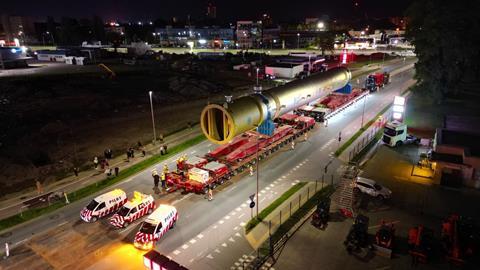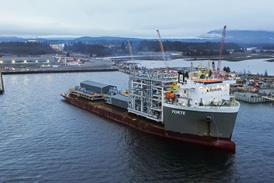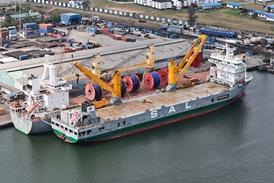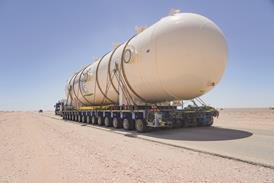Mammoet has transported and installed a 1,500-tonne residue hydrocracking unit (RHCU) for Orlen Lietuva’s refinery in Mažeikiai, Lithuania.

Orlen has been modernising its facilities in Mažeikiai to achieve future EU fuel quality requirements. The project to install the 50 m-tall RHCU formed part of the upgrade works to support greener fuel projects and increase site capacity.
Having worked on a smaller project at the site in 2008, Mammoet was already familiar with the Mažeikiai site, and the steps needed to deliver a project of this scale. Planning started in 2016, working with Orlen Lietuva and the Lithuanian Transport Authority to investigate methods and technologies to deliver the unit.
“We looked at all kinds of different options,” said global sales director, Edvinas Ivanauskas. “We considered bringing it by water and by a neighbouring country. We also considered building a temporary jetty close to the refinery; however, this was not feasible due to the environmental impact assessment. When selecting the best route, you must carry out a lot of investigation in terms of the ground, the bridges and the weather conditions.”
Cutting the RHCU and transporting it in parts was also investigated. However, this would require welding it back together at the site using a specialist welding machine, of which there are only two in Europe. The team therefore took the decision to transport it in one piece.
Constructed in Italy, the unit was shipped to Klaipeda on a heavy lift vessel from Jumbo’s fleet equipped with two 900-tonne capacity cranes. Sufficient port infrastructure was a further challenge. “A port is usually six or seven tonnes per square meter for standard operation,” explained Ivanauskas. “Basically, we took the approach to strengthen the quay and the areas around it to be able to handle the vessel. We sought special permission from the terminal owner and port authority to get approval.”
Then, the 145 km transport of the unit by road began using 88 axle lines of PST and conventional trailers, pulled by two prime movers. The journey took around 17 days, with the convoy travelling at an average speed of 3-5 km/h with movements mostly at night. This was to avoid damaging the asphalt in the summer heat and to minimise disruption for traffic and the public.
Despite this, the route still posed its challenges. Summer in Lithuania can bring heavy rainfall and, in the weeks leading up to the transportation, there was a downpour. To prevent the heavy convoy from getting stuck in the ground, steel plates were laid across the gravel routes to spread the loads.
Electric cables also needed to be temporarily disconnected, and a permanent bridge constructed for the convoy to use. Five existing bridges also needed to be reinforced, as well as culverts bridged, and several bypasses erected.
At one stage, the team had to overcome an 8 percent slope in a small valley. With the ground unstable, sheet piling was used, and two additional prime movers called in to support the convoy.
The installation of the unit was more straightforward, with Mammoet deploying a gantry crane and a 1,300-tonne capacity LR11350 tailing crane.
















